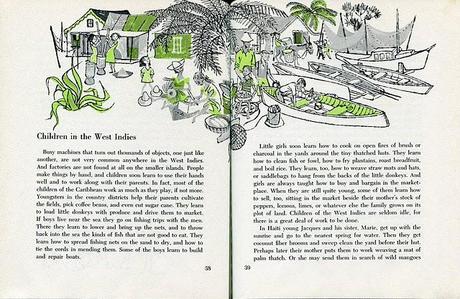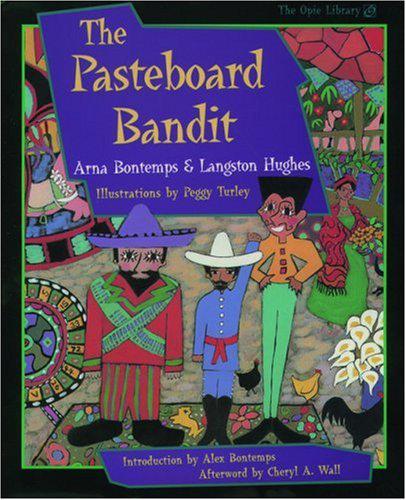MY ENTRIES FOR THE PAST TWO MONTHS have focused on the children's books of Langston Hughes and his associates. Hughes was prolific in every form that he worked in, and perhaps incredibly there are an additional five children's titles that appeared in his lifetime and several others that were published after his death. Here is a cursory look at those titles with links to lots of scans that I've posted on my Flickr sets that range from introductions to interesting excerpts to nearly complete texts.
THE REST OF THE FIRSTS

LANGSTON HUGHES'S FINAL TWO ENTRIES in Franklin Watts's The First Book series were The First Book of The West Indies (1956) and The First Book of Africa (1960). The West Indies were important to Hughes as we saw in his first children's book Popo and Fifina: Children of Haiti. In many ways The First Book of the West Indies sets out to achieve the same goal as Popo and Fifina, offering American children a glimpse into the very different world of the Caribbean. He tries to pepper it with chapters that would hold particular interest to children ("Pirates and Parrots," "Children in the West Indies"), but for the most part the book's chapters break down to the different nations ("Haiti," "The Dominican Republic," "Puerto Rico," etc.). The book is illustrated by Robert Bruce and I have posted all of Bruce's illustrations (which amounts to almost the entire book) as a Flickr set here.
The First Book of Africa takes the same form as The First Book of the West Indies and reads as a relatively dry school book. The first half of the book is dedicated to African history ("Great Kingdoms of Black Africa," "Livingstone and Stanley: Explorers," "Cecil Rhodes: Empire Builder") and the rest of the book discusses modern nations ("Kenya: A Trouble Spot," "South Africa: Land of Apartheid"). The book is illustrated with photographs and I have posted two of the more interesting chapters ("Primitive Peoples of Africa," and "Children of Africa") as a Flickr set here.
To learn more about Hughes's other First Books see my blog posts:
The First Book of Negroes
The First Book of Rhythms
The First Book of Jazz
THE FAMOUSES LANGSTON HUGHES also contributed to another series of nonfiction reference books The Famous series published by Dodd, Mead & Company. Hughes's titles are Famous American Negroes (1954), Famous Negro Music Makers (1955), and Famous Negro Heroes of America (1958). The books are illustrated with photographs, usually a single photograph of the subject at the beginning of each chapter, and the rest is straight text.
LANGSTON HUGHES also contributed to another series of nonfiction reference books The Famous series published by Dodd, Mead & Company. Hughes's titles are Famous American Negroes (1954), Famous Negro Music Makers (1955), and Famous Negro Heroes of America (1958). The books are illustrated with photographs, usually a single photograph of the subject at the beginning of each chapter, and the rest is straight text.
The Famous American Negroes were: Phillis Wheatley, Richard Allen, Ira Aldridge, Frederick Douglass, Harriet Tubman, Booker T. Washington, Daniel Hale Williams, Henry Ossawa Tanner, George Washington Carver, Robert S. Abbott, Paul Laurence Dunbar, W. C. Handy, Charles C. Spaulding, A. Philip Randolph, Ralph Bunche, Marian Anderson, and Jackie Robinson.
I have posted the complete introduction to Famous American Negroes along with the back dust jacket that shows some of the other titles in the series as a Flickr set here.
POSTHUMOUS WORKS
THE LAST BOOK that Langston Hughes prepared for publication in his lifetime was Black Misery (1969). The title was conceived by publisher Paul Eriksson as an outgrowth of Suzanne Heller's popular series of books Misery (1964), More Misery (1965), and Misery Loves Company (1967).
The book is comprised of twenty-seven out of a proposed forty-five captions. Eriksson said that Hughes even worked on the book in the hospital before he died. Suzanne Heller, a white suburbanite, turned down the opportunity to illustrate the book as she didn't feel she could do justice to the material. The book was illustrated by Lynette Logan under the name Arouni.
Oxford University Press reissued the title in 1994 with an introduction by Jesse Jackson and an afterward by Robert G. O'Meally (from which the background material on this book is taken). 
In addition to reissuing several of Hughes's children's titles, Oxford University Press has published several of his previously unpublished children's works, another collaboration with Arna Bontemps The Pasteboard Bandit (1997) and the still in print The Sweet and Sour Animal Book (1997).

The Pasteboard Bandit attempts to do for Mexico what Popo and Fifina does for Haiti, but without the strength of Popo and Fifina's journey from the village to the city and from childhood to more adult responsibilities. The Sweet and Sour Animal Book, are short poems which most interestingly are illustrated by children from the Harlem School of the Arts.
There remain several other Hughes manuscripts for children, but as of now there are no plans for future publications.
All images are copyrighted © and owned by their respective holders.

